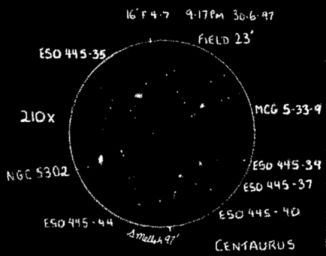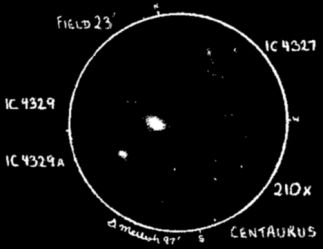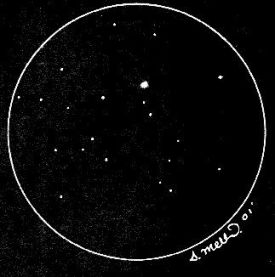SSPM9. Centaurus Galaxies
By Scott Mellish, 1997
The constellation of Centaurus has a whole host of varying objects that would satisfy the interests of nearly any keen observer. Though Centaurus borders the rich southern Milky Way, it is none the less rich in some very fine examples of galaxies. The most noteworthy are NGC 5128, and the exquisite edge-on spiral NGC 4945.
However there are many more galaxies in Centaurus that are just as interesting to observe, and I have included some in this article.
 Sketch No.1 shows NGC 5291 a reasonably bright elongated object which has a close companion called "Seashell", an extraordinary galaxy that has formed through obvious interaction with 5291 into the almost perfect shape of a seashell. Though in the 16-inch at 210x mag. all you get to see is a faint smudge adjoining 5291 that appears to be slightly bent in shape. For a better view of the seashell there is a beautiful photo of it in the book 'Exploring the Southern Sky'.
Sketch No.1 shows NGC 5291 a reasonably bright elongated object which has a close companion called "Seashell", an extraordinary galaxy that has formed through obvious interaction with 5291 into the almost perfect shape of a seashell. Though in the 16-inch at 210x mag. all you get to see is a faint smudge adjoining 5291 that appears to be slightly bent in shape. For a better view of the seashell there is a beautiful photo of it in the book 'Exploring the Southern Sky'.
Also in the field are two other faint galaxies of around 14.0 magnitude. They both appear in the eyepiece to be semi edge on spirals but there is little else to comment on here.
 Sketch No. 2 shows a marvellous field of galaxies which I found to observe. At 21Ox mag. at least 7 galaxies appeared in the field. At first I thought the small galaxy, second from the left at the bottom of the field, was a non starter but page 105 of 'Exploring the Southern Sky' has a superb full page photograph of the whole region where these galaxies are located and it makes a wonderful finder chart come tourist map for this region as it can lead you to find some of the more fainter and less conspicuous galaxies that abound throughout the area.
Sketch No. 2 shows a marvellous field of galaxies which I found to observe. At 21Ox mag. at least 7 galaxies appeared in the field. At first I thought the small galaxy, second from the left at the bottom of the field, was a non starter but page 105 of 'Exploring the Southern Sky' has a superb full page photograph of the whole region where these galaxies are located and it makes a wonderful finder chart come tourist map for this region as it can lead you to find some of the more fainter and less conspicuous galaxies that abound throughout the area.
The brightest of the group appears to be NGC 5302 it seems to be an almost face on spiral with a bright central region that views well in the 16 inch at 210x mag. Above at around 9' distant is ESO 445-35 an oval shaped galaxy of around 13.0 mag. It does appear to be slightly tilted and could be a barred spiral galaxy as an ever so slight wisp of brightness seems to cross the object. MGC 533-9 in the eyepiece appears to be the third largest and brightest of this cluster and it has a tiny fairly bright core and a round diffuse and compact outer region. This object contrasts well with the other galaxies as they all appear to be of different shapes and sizes, the other galaxies at the bottom of the field are small round objects which made it near impossible to work out their correct catalogue numbers, which is always a chore in complex galaxy clusters. However the designations on the sketch is the best guess I could give after studying the field guide to 'Uranometria'. This small group of galaxies is a must see if your touring - Centaurus as it is a lovely diverse grouping that can keep you interested for some time.
 Sketch No. 3 takes us to IC 4329 which is the brightest galaxy of the objects covered so far in this article. It is a lovely egg shaped galaxy in the eyepiece at 210x mag. , with a bright core region and a soft luminous outer halo. A rewarding object to observe in a large scope as it's surface brightness is quite high. Also in the field is IC 4329A a small compressed object with an evident core region. Quite s bright object when compared to the much larger IC 4329.
Sketch No. 3 takes us to IC 4329 which is the brightest galaxy of the objects covered so far in this article. It is a lovely egg shaped galaxy in the eyepiece at 210x mag. , with a bright core region and a soft luminous outer halo. A rewarding object to observe in a large scope as it's surface brightness is quite high. Also in the field is IC 4329A a small compressed object with an evident core region. Quite s bright object when compared to the much larger IC 4329.
At the very top of the field, north west of IC 4329 is the small and faint IC 4327, a featureless little smudge that has a very diffuse core region but it is none the less easily visible in the 16 inch at 210x mag. I found all the galaxies covered here very rewarding to observe and recommend them to anyone considering a tour through the constellation of Centaurus.

